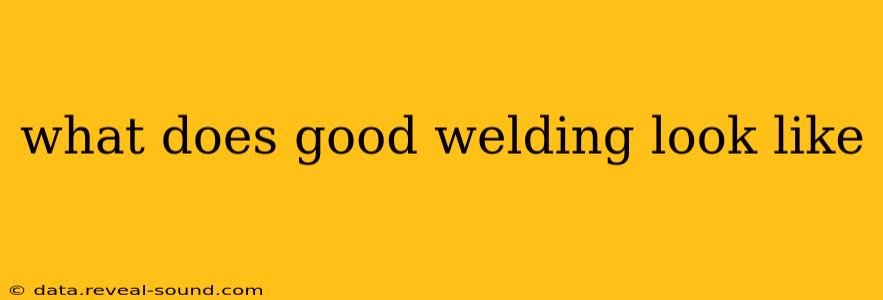Welding is a crucial process in numerous industries, from construction and manufacturing to automotive and aerospace. The quality of a weld directly impacts the structural integrity and safety of the final product. Knowing what constitutes a "good" weld is essential for both welders and those who rely on their work. This guide will delve into the visual characteristics of excellent welds, addressing common questions and misconceptions.
What are the Key Visual Characteristics of a Good Weld?
A visually appealing weld isn't necessarily a good weld, but visual inspection is the first and often most important step in weld quality assessment. Several key characteristics signal a well-executed weld:
-
Complete Penetration: The weld should fully fuse the base materials, penetrating completely through the joint. This ensures maximum strength and prevents failure along the weld line. Incomplete penetration is a major defect.
-
Consistent Bead Width and Height: The weld bead should have a uniform width and height along its length, indicating consistent heat input and proper welding technique. Variations suggest inconsistencies in the process.
-
Smooth and Consistent Surface: The surface of the weld should be relatively smooth, free from excessive spatter or porosity (small holes). A smooth surface indicates good control over the welding process and less likelihood of defects. While some ripple is normal, excessive roughness indicates potential issues.
-
Absence of Cracks or Undercutting: Cracks (fractures in the weld metal) are a serious defect, indicating weakness and potential failure. Undercutting, where the weld metal doesn't fully fill the joint, leaving a groove along the weld toe, is another major flaw.
-
Proper Fusion: The weld metal should be properly fused (melted together) with the base metal. Lack of fusion is a significant weakness, potentially leading to separation under stress. Good fusion shows a smooth transition between the weld and base materials.
-
Correct Weld Profile: The weld's shape depends on the type of weld and joint design, but should conform to the specifications. This involves factors like the weld bead's profile, leg length (for fillet welds), and reinforcement height.
What are the Different Types of Weld Defects?
Understanding common weld defects is crucial for recognizing poor welding. Some key defects include:
-
Porosity: Small holes within the weld metal, often caused by gas entrapment.
-
Cracks: Fractures in the weld metal, indicating weakness and potential failure. These can be surface cracks or internal cracks (harder to detect).
-
Incomplete Penetration: The weld does not fully fuse the base metals, creating a weak point.
-
Undercutting: A groove along the edge of the weld, weakening the joint.
-
Lack of Fusion: Failure of the weld metal to fuse properly with the base metal.
-
Slag Inclusion: Trapped slag (molten flux) within the weld, creating a weak point.
-
Excessive Concavity or Convexity: The weld bead's profile deviates significantly from the desired shape.
How Do I Know if My Weld is Strong Enough?
Visual inspection is a valuable first step, but it's not sufficient to guarantee strength. More advanced methods like:
-
Destructive Testing: Methods such as tensile testing and bend testing involve physically breaking the weld to assess its strength.
-
Non-Destructive Testing (NDT): Techniques like radiographic testing (RT), ultrasonic testing (UT), and magnetic particle inspection (MPI) allow evaluation of weld integrity without causing damage.
What are Some Common Mistakes That Lead to Poor Welding?
Poor welding often stems from:
-
Improper Welding Technique: Incorrect amperage, travel speed, or electrode angle can result in defects.
-
Contaminated Base Metals: Dirt, rust, or paint on the base materials can prevent proper fusion.
-
Insufficient Heat Input: Insufficient heat can lead to incomplete penetration and lack of fusion.
-
Excessive Heat Input: Excessive heat can cause burn-through, porosity, and cracking.
Conclusion
Determining the quality of a weld requires a multi-faceted approach. While visual inspection offers a quick assessment of key characteristics, further testing is usually needed for critical applications to guarantee strength and reliability. By understanding the characteristics of a good weld and the common defects, both welders and those who utilize welded structures can improve quality control and ensure safety.
